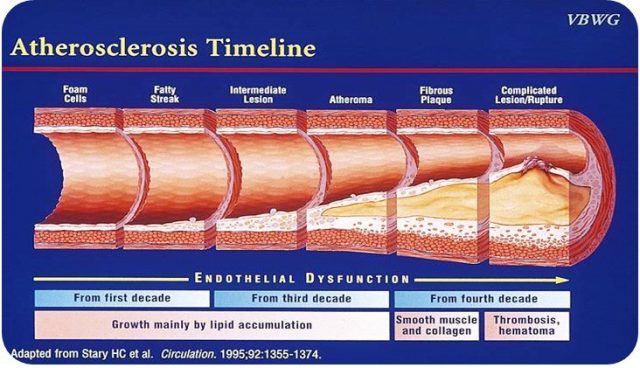Clinical Uses and Implications
Risk for Atherosclerosis
Atherosclerosis: A Symptom of Endothelial Dysfunction
Based on new clinical findings, many leading cardiac researchers now believe that endothelial dysfunction, considered as “the ultimate risk of the risk factors”, is a disease unto itself and that this disease is what causes damage to the vessels of the heart, not atherosclerosis. Furthermore, this dysfunction is triggered by an inflammatory response to the damaged endothelium. Atherosclerosis, and the subsequent plaques and arterial blockages and heart attacks that it causes, are manifestations of this endothelial dysfunction.
“The emphasis should be on prevention both from a population basis and by better identification of high-risk individuals decades before clinical cardiovascular disease occurs.”
Elaine M. Urbina, M.D., et al
Noninvasive Assessment of Subclinical Atherosclerosis in Children and Adolescents.
A Scientific Statement From the American Heart Association (2009)

Based on new clinical findings, many leading cardiac researchers now believe that endothelial dysfunction, considered as “the ultimate risk of the risk factors”, is a disease unto itself and that this disease is what causes damage to the vessels of the heart, not atherosclerosis. Furthermore, this dysfunction is triggered by an inflammatory response to the damaged endothelium. Atherosclerosis, and the subsequent plaques and arterial blockages and heart attacks that it causes, are manifestations of this endothelial dysfunction.
“The emphasis should be on prevention both from a population basis and by better identification of high-risk individuals decades before clinical cardiovascular disease occurs.”
Elaine M. Urbina, M.D., et al
Noninvasive Assessment of Subclinical Atherosclerosis in Children and Adolescents.
A Scientific Statement From the American Heart Association (2009)
The New Diagnostic Paradigm
With many leading researchers now looking at endothelial dysfunction as the risk of all heart risk factors, with atherosclerosis but a symptom of the on-going systemic dysfunction, traditional thinking about heart disease – its diagnosis and treatment – is starting to shift.
Treatments to repair the damage caused by ruptured plaque (stent, medication, angioplasty, CABG) are now viewed as palliative, not curative, in that they don’t heal the damaged endothelium.
They only delay the onset of another plaque rupture.
However, by turning the focus to the health of the endothelium at a much earlier stage in life, by assessing it with non-invasive EndoPAT™ testing, and keeping a healthy,
balanced lifestyle, levels of inflammation can be reduced and the health of the endothelium can be improved, oftentimes dramatically. This is evidenced by rising EndoPAT™ scores.
Each year in the United States, about 785,000 people will have a heart attack for the first time, while 470,000 will have a repeat attack. In about 20% of the cases, death will result. Early diagnosis with EndoPAT, however, offers a real chance to help reduce these figures significantly.

According to the American Heart Association* over 50% of coronary deaths had no previous symptoms and roughly 50% of heart attacks were not considered “high risk” patients. Demonstrated in multiple clinical studies, EndoScore (the EndoPAT test result) was proven a novel independent risk factor that predicts heart disease beyond traditional risks such as Cholesterol and Hypertension and helps guide patient management.
Through its unique, simple and safe mechanism of action, the EndoPAT is a functional and personalized diagnostic tool that provides a window to patients’ arterial health.
Together with Itamar Medical’s WatchPAT (the simplest, accurate and most reliable FDA cleared Home Sleep Test
to detect OSA and requires no early knowledge in sleep diagnosis) the wellness and health program goals can be better achieved.
Obstructive Sleep Apnea (OSA) is a major sleep disorder with a prevalence of up to 10% in the adult population. While 80% of people suffering from OSA remain undiagnosed, OSA has been shown to have serious implications on their health. Sleep Apnea is a major comorbidity to many underlying diseases, including Hypertension,
Obesity, Diabetes, Cardiovascular disease and more. Many of these diseases cannot be treated
effectively if OSA is left untreated.
WOMEN’S HEALTH
Heart Disease and Women
Heart disease is the leading cause of death for women in the United States, killing approximately 1 in 4 women* within the first year, compared to 1 in 5 men. In addition, female heart patients required longer hospital stays and incurred higher medical bills than males.
Heart disease is not gender neutral, according to findings from the Women’s Ischemia Syndrome Evaluation (WISE) study, the landmark investigation into ischemic heart disease in women.
Discoveries from the WISE study suggest that many women have coronary microvascular dysfunction that is not detected by standard diagnostic procedures and therefore goes unrecognized and untreated.
Heart attacks are less likely to occur in pre-menopausal women than in age-matched men, a benefit attributed to estrogen. But doctors also assumed that when women developed heart disease it was atherosclerotic plaque restricting blood flow in the coronaries. Consequently, procedures to diagnose and treat heart disease were biased on research conducted in male-only studies.

In the 1970s, a study conducted by the National Institutes of Health launched the Coronary Artery Surgery found that women with a positive stress test was 4.5 times more likely than men with a positive stress test to have an angiogram showing no blockages.
*Facts on Women and Heart Disease, Centers for Disease Control and Prevention, 2015
